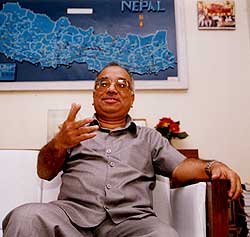 Nepali Times: What challenges does the NEA face?
Nepali Times: What challenges does the NEA face? Janak Lall Karmacharya: Our first challenge is to make NEA more efficient and commercially oriented. The others are rural electrification and reduction in generation cost. We are looking for ways to tackle these challenges effectively and appropriately.
Any projects underway?
Chilime hydropower will be commissioned in a few months and the 70 MW Middle Marsyangdi is under construction. The World Bank recently agreed to help us establish a Power Development Fund and we have approached the Japanese for the construction of Kulekhani III. The NEA is trying to woo investors for the 122 MW Upper Seti. We have completed studies of the Kankai project. The other big storage projects in the pipeline are a 300 MW project in Jajarkot and a proposal for Uttar Ganga.
And what of West Seti?
Well, the promoters are focusing on trying to get a power purchase agreement with our neighbour in the south. The present discussion and differences of opinion are normal in these processes. I am confident they'll reach a point of consensus soon. It is a 750 MW project, which is too huge a storage project for our system. There is no possibility of the NEA financing such a huge project, but we can consider developing it as a joint venture. However, for the NEA to get involved we would need a few requisites: the present developer should first withdraw, the Indian power market should open and we should be able to find an appropriate investor or partner.
How do you assess your first year of tenure?
When I became the managing director of the Nepal Electricity Board, the corporation functioned like a single entity, making it difficult to assess what was running efficiently and what was a dead weight.
Among the first things I did was to make structural changes by creating three core sections for generation, transmission and distribution. Engineering was later identified as another important sector. As a result the authority, responsibility and accountability for everything was clearly defined. Implementation was arranged between these core businesses and the management with performance indicators for periodic evaluations.
These performance contracts outlined the freedom and authority each core business enjoys. About 50 percent of the performance indicators concentrate on loss reduction and performance audit periods (PAP) are half-yearly. Our first performance contract is with the distribution sector because almost 60 percent of the NEA staff work in this revenue-generating sector.
What kind of loss-reduction methods have you adopted?
The distribution centres have to reduce losses by 0.5 to 6 percent depending on how much loss is incurred. Of the average 23 percent loss, half is due to non-technical reasons. The city of Bhaktapur registers the highest loss for us at 55 percent. We hope the Anti Theft Act is made effective soon so electricity pilfering is a criminal offence and the NEA can make arrests. At present we are restricted to petty fines after which the perpetrators get off scot-free.
Do you have any conflicts of interest with the Ministry of Water Resources?
We have full support from the ministry for structural reforms and are working on new proposals for seasonal tariffs and community involved distribution systems suggested by Minister Gyawali. We should be able to implement the community involved distribution system in the coming fiscal year. Within six months to a tear we hope to bring down electricity rates on par to that of LPG.
How enthusiastic are donors about rural electrification?
Neither the NEA nor the government is in a position to expand the rural electrification drive. This is why we need donor help, and so far, they have been very supportive. Their main condition with regard to electrification is poverty alleviation in rural areas.
The Asian Development Bank gave us a $50 million loan for rural electrification and we just signed an agreement with the World Bank too. The Swiss Interntional Development Agency (SIDA) will also be investing and DANIDA is already working in Kailali-Kanchanpur. The NEA is not going to turn a profit by selling electricity to rural users. Whatever we earn will be ploughed back into extending the service to other areas.
Have the donors pressurised the NEA to revise tariff rates?
Every donor needs to be assured about repayment before they make an investment. They want us to achieve a certain rate of return, which I believe we can achieve through the structural changes and loss reduction attempts the NEA is making. A price hike is not on the cards for now.


